




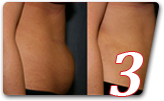
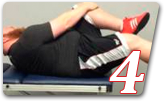
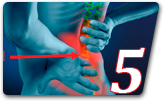
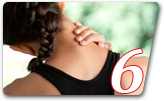

Instead of experiencing a constant decline in your physical fitness levels and overall health, strengthen your core, get flat abs, and feel great. Prioritizing your abs (and low back) will lead you towards better health.
But it's important you go about training them the right way.

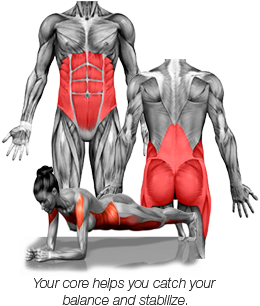
Functionally speaking, your core helps you catch your balance and stabilize. This means every time you take a step, your core helps you avoid falling over. And every time you lift a heavy weight, or extend your arms/legs out in front or behind you, it's your core stabilizing you and preventing you from tipping over.
So, we train your core with bodyweight exercises, occasional use of heavy weights, unstable surfaces, and multiple speeds of movement. The more we mix it up, causing your body to react, stabilize, and re-center, the better we are training your core for the real world.
In terms of frequency, it's important to train your core at least 5 days/week when you want to progress quickly.
However, there are a few exceptions to this:

Exception #1: Heavy exercises -- if you're choosing a lot of heavier exercises to build core strength, rather than mobility or endurance, it's important to rest until you are no longer sore before lifting heavy again. Generally speaking, it takes 48-72 hours, and 'not sore' is determined by a pain scale, as follows:

On a scale of 0 to 10, where:
0 = no pain/soreness whatsoever
10 = worst pain/soreness imaginable
A strength-based workout should get you to a 5-7 out of 10; you'll want to be 3 or less before your next workout on the same muscle groups.
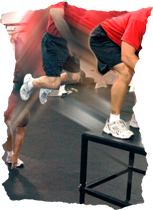
Exception #2: Power-based exercises -- generally speaking, you'll want to rest two to three days in between every power workout. This is because you're asking your body for maximal exertion and it takes time to recover. During power phases of a training program, I often recommend muscle balancing exercises on off days to avoid injury and keep moving.
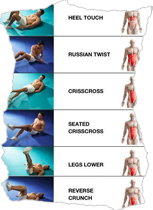

Exception #3: Maintenance phases -- as with any training program, training your abs/core should be goal-based and fully periodized. This means it's important you pick three isolated phases that are six week each, and assign logical goals to each one. Basically, if abs/core is your main focus, that will be your middle six weeks; your first six weeks will be prep work, and your last six weeks will be recovery. During prep and recovery phases, you'll want to stick to 2-3 days/week on any abs or core exercises and avoid the heavier exercises.
To help you understand 'periodization', here's a practical example as it relates to abs training:
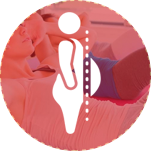
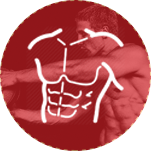
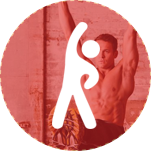
After 18 weeks, simply repeat or mix it up and work on another goal.
You'll notice I've chosen bodyweight abs/core workouts for the first and last phase, as these are 'maintenance' phases, and our goal is to improve mobility and endurance, rather than power and strength. This brings up an important topic about intensity:
Your goal should be to hit 8-9 out of 10 intensity on every high interval of every set; every low interval is meant for active rest, so it's a 2-3 out of 10 intensity, if that. Often times, you'll use your low intervals simply to change to a new exercise, prep yourself, and get started.
For the most part, it's a good idea to stack 10 different exercises together into a circuit, on one minute intervals. This way, you can choose 50/10, 40/20, 30/30, 20/40, or 10/50 for your high/low intervals, respectively, and mix it up over time.
You'll want to sequence the exercises in a particular order, so you can make sure to rest one group of muscles while working another and so on. Here's an example workout, to make things more clear:

Perform each of the following exercises for 40 seconds at high-intensity (as fast -- or heavy -- as you can go!) and rest for 20 seconds as you prepare for the following exercise. Your goal should be to hit complete fatigue by the end of every high interval. When you have completed all ten exercises, your workout is over.
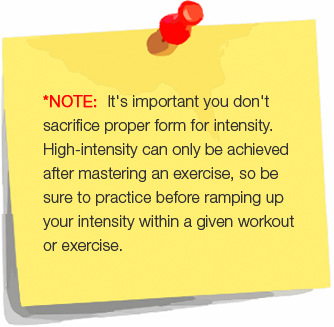
At times, there are advantages to re-organizing an abs workout, changing it so you have supersets of related muscle groups, or giant sets in cluster format to build muscle a bit more quickly, but the same could be said for mixing it up in any other way with your workout program.
The main reasons I choose the workout format above for abs training are:


Many of the exercises chosen in the workout above are full-body exercises; and, you might also notice typical abs crunches, sit-ups, leg throws, and other dangerous abs exercises are not listed. These exercises can result in injury to your neck, low back, or elsewhere and they are not recommended.
You see, a typical crunch, sit-up, or leg throw ends up placing almost all the strain through your neck and hip flexors, instead of your abs and core. When you do this, you actually weaken the strength of the nerve signal leading to your core, and you make it next to impossible to recruit your actual core muscles.
Besides, those exercises are training the wrong muscles, the wrong way. For clarity, you have 'bracing' abs muscles and 'stabilizing' abs muscles. The latter are part of your core. Let's take a closer look at which exercises concentrate on which type of abs muscle:

Bracing muscles (fake core): rectus abdominus, rectus femoris, gluteus maximus, medius, and minimus, paraspinals, quadratus lumborum
Stabilizing muscles (true core): transversus abdominus, internal oblique, external oblique, psoas, multifidus
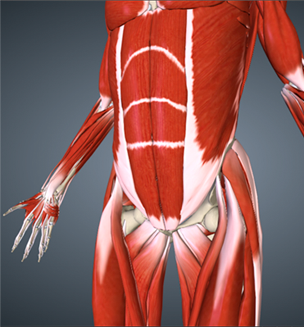

Yet, sometimes you choose the right exercises and your body might choose the wrong muscles. This can be because of old habits, or because your nervous system isn't well organized for movement. The solution, regardless, is to create new muscle memory.
Here's how I recommend you go about creating new muscle memory:

At first, you'll want to correct every little mistake you make. Over time, you'll want to think about how you performed at the end of every set; eventually, at the end of every workout. By fading your feedback over time, you'll learn more quickly.

Last but not least, we need to discuss food. Most people get this all wrong -- the rule is simple -- eat food that is good for you.
The #1 mistake most people make with their diet is allowing small amounts of "abs-poison" to seep in. For example, you might have a few bites of ice cream every couple of days, eat some deep fried food from time to time, or have "only" a soda or two per day.
If it's not a whole food and/or you don't feel at least as energetic after eating as you did when you sat down, it's not actually "food" for your body. This is one of the most important lessons I can teach you.
Now, "good" for you can be confusing, so let's go back to basics:
When you simplify nutrition to 'eating whole foods' and 'feeling-based eating', you are adapting your diet in a very natural way, and your abs will naturally want to pop out.
The easiest and fastest way to a flat stomach is cleaning up your diet.
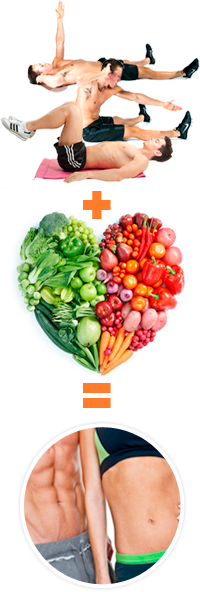
A flat stomach helps you recruit your core, and your core helps your flat stomach look and feel so much better. Eat well; redefine food's purpose to nourish your body and fuel it for your day.
Remember, your core supports your CNS, which is the communication center to the rest of your body. Abs are made in the kitchen and through intensity. By spending 10 minutes training your core with dynamic and unstable exercises, you'll be able to achieve a balance reaction and stimulate your metabolism at the same time. Learn to alternate the emphasis on different body parts with each exercise -- but still include as many joints as possible -- and see your results accelerate. Finally, reprogram your body to recruit your core, and avoid using bracing muscles in its place.
As you can see, there's a lot that goes into designing an abs training program. And, as you might have guessed, I'm interested in helping you get great results. Instead of being focused on choosing the perfect exercises, intensities, reps, rest periods, intervals, and equipment, I'd rather you focus on scheduling your workouts, keeping track of your results, and measuring your progress over time.
Besides, if you get even half the results of our other clients, you won't be sorry. Go ahead and click the add 'activate my membership' button below: (*results may vary)
